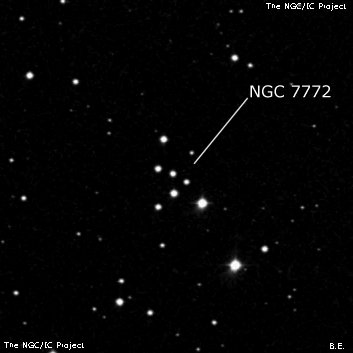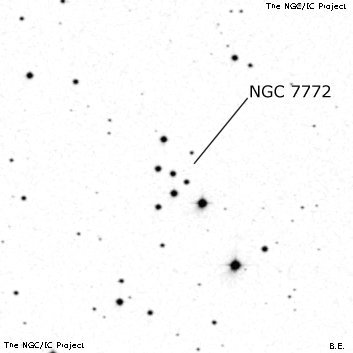NGC/IC Project Restoration Effort
(This is a very very beta version)
NGC7772


Basic Information
Location and Magnitude
Right Ascension: 23:51:45.0
Declination: +16:14:54
Constellation: PEG
Visual Magnitude:
Historic Information
Discoverer: Herschel J.
Year of discovery: 1825
Discovery aperture: 18.3
Observational
Summary description: Cl of sc st 10 m
Sub-type: III1p
Corwin's Notes
=====
NGC 7772 is an astersim of 7 stars, the southwestern brighter than the others.
While probably not a physical cluster, it is a striking object, well isolated,
and would probably stand out quite nicely at the eyepiece.
This is one of JH's earliest discoveries, found in his Sweep No. 11 (of 810!)
on 7 October 1825. Even though his published RA carries a double colon, it is
accurate. His descriptions in the early sweeps tend to be terse; this one is
no exception: "A cluster of scattered stars 10m." This is, nevertheless,
appropriate to the object.
As far as I know now (May 2016), this explanation for the NGC number was first
proposed by Andrew Young in the January 1963 Sky and Telescope (Vol. 25,
p. 14) "Letters" column. Andy was citing a question posed by Walter Scott
Houston, in his "Deep Sky Wonders" column in the October 1962 issue (Vol. 24,
p. 221) -- Scotty had run across the object plotted in Norton's Atlas, but
found nothing remarkable on the sky. He gave an approximate position of
23 49.0, +15 59 (1950), close to the position of the asterism. The compilers
of Norton's Atlas apparently thought enough of the object to include it, but
they had several other deep sky objects plotted that puzzled those of us using
the Atlas regularly. Given Norton's importance to an earlier generation of
amateurs, it would be interesting to us to know a little of the history of the
Atlas. Half a century on, I certainly don't remember any of that history
myself. But I certainly do remember pouring over the Atlas as an eager
teenaged observer, trying to find many of its deep sky objects!
Steve's Notes
=====
NGC 7772
13.1" (9/29/84): small group of 7 stars from mag 11.5-14.5. The two brightest stars are at the southwest and north end. The other five stars are arranged in a distinctive "V" asterism with a vertex and open to the east. The status as a cluster is questionable and this group may be an open cluster "remnant".



